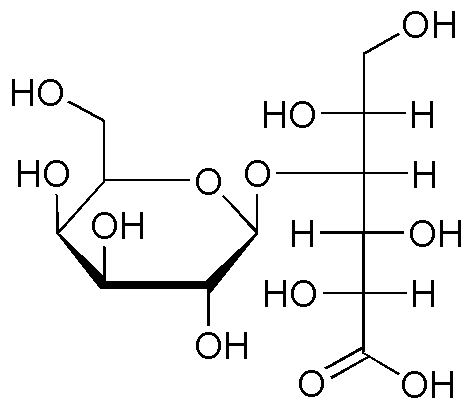Lactobionic acid is widely utilized in research focused on:
- Pharmaceutical Formulations: It acts as a stabilizer and excipient in drug formulations, enhancing the solubility and bioavailability of active ingredients, which is crucial for effective medication delivery.
- Food Industry: Used as a natural sweetener and preservative, it helps improve the texture and shelf life of dairy products and other foods, appealing to health-conscious consumers.
- Cosmetic Products: Its moisturizing properties make it a popular ingredient in skincare formulations, providing hydration and improving skin texture, which is beneficial for anti-aging products.
- Biomedical Applications: In tissue engineering, it serves as a biocompatible scaffold material, promoting cell adhesion and growth, which is essential for regenerative medicine.
- Research in Glycobiology: Lactobionic acid is used in studies related to carbohydrate chemistry, aiding in the understanding of glycan interactions and their implications in various biological processes.
General Information
Properties
Safety and Regulations
Applications
Lactobionic acid is widely utilized in research focused on:
- Pharmaceutical Formulations: It acts as a stabilizer and excipient in drug formulations, enhancing the solubility and bioavailability of active ingredients, which is crucial for effective medication delivery.
- Food Industry: Used as a natural sweetener and preservative, it helps improve the texture and shelf life of dairy products and other foods, appealing to health-conscious consumers.
- Cosmetic Products: Its moisturizing properties make it a popular ingredient in skincare formulations, providing hydration and improving skin texture, which is beneficial for anti-aging products.
- Biomedical Applications: In tissue engineering, it serves as a biocompatible scaffold material, promoting cell adhesion and growth, which is essential for regenerative medicine.
- Research in Glycobiology: Lactobionic acid is used in studies related to carbohydrate chemistry, aiding in the understanding of glycan interactions and their implications in various biological processes.
Documents
Safety Data Sheets (SDS)
The SDS provides comprehensive safety information on handling, storage, and disposal of the product.
Product Specification (PS)
The PS provides a comprehensive breakdown of the product’s properties, including chemical composition, physical state, purity, and storage requirements. It also details acceptable quality ranges and the product's intended applications.
Certificates of Analysis (COA)
Search for Certificates of Analysis (COA) by entering the products Lot Number. Lot and Batch Numbers can be found on a product’s label following the words ‘Lot’ or ‘Batch’.
*Catalog Number
*Lot Number
Certificates Of Origin (COO)
This COO confirms the country where the product was manufactured, and also details the materials and components used in it and whether it is derived from natural, synthetic, or other specific sources. This certificate may be required for customs, trade, and regulatory compliance.
*Catalog Number
*Lot Number
Safety Data Sheets (SDS)
The SDS provides comprehensive safety information on handling, storage, and disposal of the product.
DownloadProduct Specification (PS)
The PS provides a comprehensive breakdown of the product’s properties, including chemical composition, physical state, purity, and storage requirements. It also details acceptable quality ranges and the product's intended applications.
DownloadCertificates of Analysis (COA)
Search for Certificates of Analysis (COA) by entering the products Lot Number. Lot and Batch Numbers can be found on a product’s label following the words ‘Lot’ or ‘Batch’.
*Catalog Number
*Lot Number
Certificates Of Origin (COO)
This COO confirms the country where the product was manufactured, and also details the materials and components used in it and whether it is derived from natural, synthetic, or other specific sources. This certificate may be required for customs, trade, and regulatory compliance.


